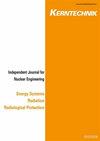Evaluation of the optimum safety performance of the nuclear reactor compact grounding system under lightning strikes and ground fault
IF 0.9
4区 工程技术
Q4 NUCLEAR SCIENCE & TECHNOLOGY
引用次数: 0
Abstract
Abstract The electrical system of a nuclear reactor facility (NRF) must incorporate a grounding grid in order to ensure it functions safely and reliably. Any disturbance in the electrical system affects the nuclear process, so it is, therefore, crucial to estimate the safety performance of the research nuclear reactor facility grounding system. The paper discusses CYMGrd 6.3, which is based on IEEE Standard 80-2013, and the optimization approaches for finding the best grounding grid design for a nuclear reactor facility connected substation of 500/11 kV in the case of a ground fault and lightning strikes. The result shows that the surface, step and touch potentials along the diagonal coordinates of the proposed grounding grid are below the safety limits in case of a ground fault but also results indicate that 100 kA lightning stroke poses a considerable threat to reactor equipment and personnel safety because the measured grid surface potential exceeds the safe ground potential rise of 3.2 kV standard at the striking point in conjunction with the proposed ground grid, so it must be modified. In this paper, three different optimization algorithms are investigated in order to determine the optimal design of the grounding grid with respect to mesh size: gradient method (GM), the genetic algorithm (GA), and simulated annealing (SA). These methods are used to achieve the purpose of obtaining an effective ground grid design. Comparing these techniques of GM and SA is good for quickly locating local minima, but they may fail to identify global solutions. In contrast, a genetic algorithm is often excellent at achieving a global minimum. Also, the utilization of GA, SA, and GM achieve the reduction of the surface potential of a proposed grounding grid by 16 %, 10 %, and 6 % respectively.评估核反应堆紧凑型接地系统在雷击和接地故障情况下的最佳安全性能
摘要核反应堆设施电气系统必须安装接地网,以保证其安全可靠地运行。电力系统中的任何扰动都会影响核过程,因此研究核反应堆设施接地系统的安全性能评估至关重要。本文讨论了基于IEEE 80-2013标准的CYMGrd 6.3,以及核反应堆设施连接的500/11 kV变电站在接地故障和雷击情况下最佳接地网设计的优化方法。结果表明,在发生接地故障时,拟建接地网沿对角坐标方向的表面电位、台阶电位和接触电位均低于安全限值,但100 kA雷击对电抗器设备和人员安全造成相当大的威胁,因为在与拟建接地网连接的击点处,实测到的电网表面电位超过3.2 kV的安全接地电位上升标准,必须进行修正。为了确定接地网的最优设计,本文研究了三种不同的优化算法:梯度法(GM)、遗传算法(GA)和模拟退火算法(SA)。采用这些方法是为了达到获得有效地地网设计的目的。比较这些GM和SA技术有助于快速定位局部最小值,但它们可能无法识别全局解。相比之下,遗传算法通常在实现全局最小值方面表现出色。此外,GA、SA和GM的利用分别使所提出的接地网的表面电位降低了16% %、10% %和6% %。
本文章由计算机程序翻译,如有差异,请以英文原文为准。
求助全文
约1分钟内获得全文
求助全文
来源期刊

Kerntechnik
工程技术-核科学技术
CiteScore
0.90
自引率
20.00%
发文量
72
审稿时长
6-12 weeks
期刊介绍:
Kerntechnik is an independent journal for nuclear engineering (including design, operation, safety and economics of nuclear power stations, research reactors and simulators), energy systems, radiation (ionizing radiation in industry, medicine and research) and radiological protection (biological effects of ionizing radiation, the system of protection for occupational, medical and public exposures, the assessment of doses, operational protection and safety programs, management of radioactive wastes, decommissioning and regulatory requirements).
 求助内容:
求助内容: 应助结果提醒方式:
应助结果提醒方式:


